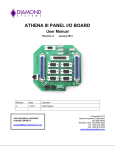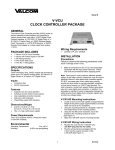Download Video Platform User Manual - SiPS - INESC-ID
Transcript
PRELIMINARY Video Platform User Manual V2.0, Rev. 1.1 (5/25/2005) • 1 Overview This datasheet describes a compact configurable platform, capable of real time video processing, based on a board equipped with a FPGA. The board has been designed to meet the high demanding characteristics of real time video processing. This inexpensive and costeffective platform can be easily used and configured for different types of algorithms and applications. It provides interfaces with a digital camera and with an output video peripheral for video display. It is also equipped with a standard bus connector to allow debug or stream data input/output or to attach expansion modules. In fig. 1 is presented the block diagram of the platform. VGA Generic Connector Camera Connector Figure 1: Block diagram of the platform. 2 Features The developed board presents the following main features: • Xilinx Spartan3 XC3S400 FPGA as the processing core with: o 400K system gates, o 288Kb of RAM in 16 blocks, o Sixteen 18-bit multipliers, o Fast carry look-ahead logic, o JTAG configuration or through Serial PROM; • • • • • Xilinx XCF02S serial configuration flash PROM (On-board FPGA boot); Two 100-mil spaced, right angle DIP, expansion connectors: o “Camera Connector”: 32-pin header providing 25 I/O pins, including two Global Clock inputs, supports several camera modules from Omnivision, o ”Generic I/O Connector”: 40-pin socket providing 37 I/O pins, including four GCLK inputs, supports several expansion modules provided by Diligent; VGA true color display port, with three 20MHz conversion rate video DACs; On-board user interface: eight LEDs, one 4-way slide switch, two push buttons; 50MHz HCMOS 3.3V oscillator; Three 3A power regulators (1.2 V, 2.5V and 3.3V) and one 1.5A, 5V power regulator. 3 Platform Description The employed FPGA has sixteen embedded 18-bit multipliers, fast carry lookahead logic and a total of 400K system gates. This gives the developer enough resources to perform video processing. The development can be performed by designing the circuits in VHDL, using the free ISE WebPACK software tool from Xilinx. To provide the interface with a standard VGA monitor, this design employs three high speed video DACs capable of a conversion rate up to 30MHz. These devices generate the red (R), green (G), blue (B), analog color signals require for the VGA interface. Impedance adaptation is ensured using a triple video buffer. Contact: INESC I&D, Signal Processing Systems Group (SiPS), Rua Alves Redol, 9, 1000-029 Lisboa, Portugal, +351 21 3100378, +351 21 3145843, http://sips.inesc-id.pt/videodevkit Document: VPv20r11-01 Video Platform User Manual 32 31 39 40 Camera Connector 2 1 Generic Connector OSC 1 2 VGA Connector The board has been designed to be compatible with several expansion modules, like the provided by Digilent. The employed expansion connectors use standard 100mil spacing and can easily be found in common distributors. These connectors make available: I/O pins, one or more supply voltages and a reference ground signal. Furthermore, as currently CMOS sensors are capable of relatively good image quality, the board was equipped with a connector capable of receiving several development camera modules from Omnivision. Since the development modules can be equipped with different image sensors, the voltage level applied to “Camera Connector” can be configured. With this platform it is provided a simple VHDL description of an image capture module with the corresponding camera register configuration module. Table 1 presents a summary of all the signals routed on the Video Board. A more detailed description of these circuits can be found in the following sections. Figure 2 presents a simplified layout of the components in the Video Board, which has been implemented with a four layers; the two internal corresponding to power/ground planes. Figure 2: Simplified layout of the Video Board. Power Supplies: • VCCu – Unregulated power supply voltage; • VCCo – 3.3V, routed on a PCB plane, employs a 3A PWM regulator, I/O supply voltage for the FPGA; • VCCaux – 2.5V auxiliary supply, required for the FPGA and for the camera expansion connector, also uses a 3A PWM regulator; • VCCint – 1.2V core supply, provides the supply voltage to the FPGA; • VCC – 5V provides power to the DACs or for the “Camera Connector”, maximum of 1.5A; • GND – System ground to all devices except the analog ground of the DACs. Video Port: • DR0-DR7 – Digital red data signal bus that connect to a DAC; • DG0-DG7 – Digital green data signal bus that connect to a DAC; • DB0-DB7 – Digital blue data signal bus that connect to a DAC; • CLK_dac – Clock signal for the DACs; • HS – Horizontal VGA synchronization; • VS – Vertical VGA synchronization; • RGB – Analog VGA color channels. On-board Devices: • LED0-LED7 – User controllable LEDs; • BTN0-BTN3 – User controllable slide switch inputs; • BTN4-BTN5 – User controllable push button inputs; • Power Fail – Overvoltage condition LED; • Power Good – Normal supply status LED; • CLK – HCMOS oscillator connected to GCLK5; Expansion Connectors: • C01-C32 – Signals that connect the “Camera Connector” to the FPGA and to the power supplies; • G04-G40 – Signal bus that connects the FPGA to the “Generic I/O Connector”. • VTO – Analog Video signal output; Table 1: Video Board signal definitions. V2.0, Rev. 1.1 (5/25/2005) Page 2 of 8 Video Platform User Manual 4 VGA Display Port The display port is based in three separate 8-bit DAC converters, TLC5602C, one per RGB channel. This DAC presents low power consumption and a maximum conversion rate of 20MHz. The signal conditioning for VGA port is performed using high speed video buffers with a 75Ω resistance in series with the output. The voltage level required for powering the DAC is generated using a TPS78601, an ultra low-noise, low-dropout linear regulator with a maximum output current of 1.5A. The FPGA pin assignments for the tree converters are presented in table 2, the clock signal for the all DACs is provided by the FPGA pin 140. Table 2: FPGA pins for the video DACs. Data Red FPGA PIN Function 106 DR0 (LSB) 107 DR1 108 DR2 109 DR3 111 DR4 113 DR5 114 DR6 115 DR7 (MSB) Data Green FPGA PIN Function 116 DG0 (LSB) 117 DG1 119 DG2 120 DG3 122 DG4 123 DG5 124 DG6 125 DG7 (MSB) Data Blue FPGA PIN Function 126 DB0 (LSB) 128 DB1 130 DB2 131 DB3 132 DB4 133 DB5 135 DB6 137 DB7 (MSB) Note: when using this video port please ensure that the clock input of video DACs is lower than 20MHz. The three analog voltage level generated by these DACs (RGB), together with the Horizontal Sync (HS) and the Vertical Sync (HS) are connected to a PCB mounted, 15-pin sub-HD socket (standard VGA). Figure 3 describes the mapping of these pins in socket and table 3 summarizes the function of each pin. Table 3: VGA socket pin mapping. Figure 3: VGA socket pin description. V2.0, Rev. 1.1 (5/25/2005) FPGA PIN 138 139 - Number 1 2 3 4 5 6 7 8 9 10 11 12 13 14 15 VGA analog Red analog Green analog Blue N. C. Ground Ground Ground Ground N. C. Ground N. C. N. C. HS VS N. C. Page 3 of 8 Video Platform User Manual To implement this video out interface, a VHDL module is provided with the board to generate the synchronization signals necessary for a standard VGA monitor. The adopted configuration uses a resolution of 640 x 480 and a refresh rate of 60Hz. The provided implementation uses a simple stage machine to generate the signals necessary to control the image display. The image to be visualized can be stored into a frame memory block or be provided directly by the processing modules. Figure 4 shows the temporal diagram of the VGA signals and Table 4 the necessary timings for the signals. Table 4: VGA Timings. Figure 4: VGA timing diagram. Symbol Parameter VS HS TS Period 16.7 ms 32 µs Tdisp Display time 15.36 ms 25.6 µs Tpw Sync pulse width 64 µs 3.84 µs Tfp Sync front porch 320 µs 640 ns Tbp Sync back porch 928 µs 1.92 µs 5 Oscillator A 50MHz oscillator with a 3.3V maximum amplitude is used. This HCMOS SMD device presents an accuracy of 50ppm. The oscillator is connected to one GCLK FPGA pin (P181) and is located close to the FPGA. Oscillators for different frequencies can be employed by request. Using the DCMs (Digital Clock Managers) available in the Startan 3 FPGA other frequencies can also be synthesized. 6 Power Supply This board requires a power supply with an output voltage within the range of 5V to 6V DC. The input voltage is monitored using a MAX4841, which provides overvoltage protection up to 28V. If the unregulated input voltage is above 5.8V the MAX4841 disables a FET transistor isolating the remaining circuit. The “PWR Fail” led indicates overvoltage condition. The DC power socket must be connected to a 2.1mm female center-positive plug and the supply must be capable of delivering at least 1A. The board generates a total of four voltage levels, 1.2V, 2.5V, 3.3V and 5V. In order to save power, all the supply voltages except the 5V are generated using a MAX1830/MAX1831 a low voltage PWM (Pulse Width Modulation), step-down regulator, which delivers a current of up to 3A with a peak efficiency of 94%. Some of these voltages, as well as the unregulated input are available through the expansion connectors. To achieve a more efficient PDS (Power Distribution System) this board uses a four layer PCB with the inner layers dedicated to ground and power. Most of the power plane is at 3.3V but is divided into several islands, one for each DAC and more two for the other supply voltages required for the FPGA. The ground plane is also divided, but in a more simple manner. All the digital circuitry shares the same plane, only the analog part of the DACs has a separate ground. All the I/O pin operate with 3.3V, but some of the FPGA banks can be connected to other voltage levels by request. V2.0, Rev. 1.1 (5/25/2005) Page 4 of 8 Video Platform User Manual 7 FPGA Configuration The FPGA can be configured using a six pin JTAG header; fig. 5 shows the function of each pin in the connector. The header can be connected to a standard JTAG programming cable (Digilent JTAG3), the Vcc pin is connected to the 3.3V supply voltage. It also employs the XCF02S serial configuration flash PROM to store FPGA configuration data. Using this design, the FPGA can automatically boot from the on-board PROM whenever the power is applied. The configuration of the PROM is also done through the JTAG header. . . . Control Switches . RGB . . Figure 5: JTAG connector pin order. 8 On-board User Interface The slide switches can be used to connect either VCCo or GND to the FPGA pins.The slide switch in the OFF position pulls the FPGA pin to ground and in the ON will go high. The output of the push button is normally pulled to VCCo, when pressed is pulled to ground. No active debounce circuit was employed in either interface. The board also provides 8 LEDs as output circuits and those LEDs are driven directly from the FPGA pins. The LEDs are accessible through the pins presented in table 7 and are active high. Table 6: FPGA pins for the slide switches and the push buttons. FPGA PIN Function PIN num 156 BTN0 1 155 BTN1 2 154 BTN2 3 152 BTN3 4 150 BTN4 149 BTN5 - V2.0, Rev. 1.1 (5/25/2005) Table 7: FPGA pins for the leds. FPGA PIN Function 19 LED0 18 LED1 16 LED2 15 LED3 13 LED4 12 LED5 11 LED6 10 LED7 Page 5 of 8 Video Platform User Manual 9 Image Capture The board is pin compatible several digital camera modules from Omnivision like the camera module based on the OV7620 CMOS image sensor or other modules with more recent sensors like the OV9650. All camera functions can be configured using a serial data transmission protocol, SCCB, which is a simplified version of the Philips I2C protocol. A VHDL implementation of this protocol is supplied, the desired register values are provided by a simple VHDL ROM like description. Considering a camera module with the OV9650 sensor, it can be programmed to capture frames in SXGA, VGA, QVGA and other specific formats or other programmed format. Frame synchronization is performed by detecting a high pulse in the vertical sync (VSYN) signal and a new line occurs with a low pulse on the horizontal reference (HREF) signal, moreover, the camera also provides the pixel clock (PCLK) signal. Figure 6 shows the temporal diagrams of those signals. Figure 6: Camera module sync signals. The pixels information is updated every falling edge of the PCLK signal, which means that pixel information can be read on the rising edge of PCLK, the VHDL description of this module is provided. 10 Expansion Connectors This board provides two expansion connectors; both can provide supply power to an expansion module. The pin arrangement is not equal for the two connectors. As the ”Camera Connector” must receive data from a digital camera the pin arrangement must be the same than for the camera module. The power pins of this connector can be configured through JP1 to be 5V or 2.5V, depending on the camera module. Both connectors are close to the FPGA, thus these connectors will exhibit a small signal delay, and high data transfer rates. RGB 8-bit DACs JTAG 24 PROM XILINX SPARTAN XC3S400 25 37 Generic Connector Camera Connector All the available I/O signals from the FPGA can be seen in fig. 7, and the mapping of all the pins is shown in table 10. VGA Table 6 shows the pin mapping between the FPGA I/O and the ”Camera Connector”. There is also a two pin header that provides the analog output video signal, if the employed module provides this output. Table 7 shows the FPGA pins for the ”Generic I/O Connector” expansion slot. Control Switches LEDs 8 6 Figure 7: FPGA available I/O signals. V2.0, Rev. 1.1 (5/25/2005) Page 6 of 8 Video Platform User Manual Table 8: FPGA pins for camera connector expansion slot. FPGA PIN Function 178 176 180* 182 187 185 190 189 194 191 197 196 198 199 GND 200 GND 183* 184* Vccaux/Vcc ** GND Vccaux/Vcc ** 203 204 205 2 3 4 5 7 GND VTO * GCLK pin ** Configured through JP1 V2.0, Rev. 1.1 (5/25/2005) Number C01 C02 C03 C04 C05 C06 C07 C08 C09 C10 C11 C12 C13 C14 C15 C16 C17 C18 C19 C20 C21 C22 C23 C24 C25 C26 C27 C28 C29 C30 C31 C32 Table 9: FPGA pins for the generic expansion slot. FPGA PIN 52 101 102 97 100 95 96 93 94 90 92 86 87 83 85 80* 81 78 79* 76* 77* 72 74 68 71 65 67 63 64 61 62 57 58 50 48 46 48 * GCLK pin Function GND Vccu Vcco Number G01 G02 G03 G04 G05 G06 G07 G08 G09 G10 G11 G12 G13 G14 G15 G16 G17 G18 G19 G20 G21 G22 G23 G24 G25 G26 G27 G28 G29 G30 G31 G32 G33 G34 G35 G36 G37 G38 G39 G40 Page 7 of 8 Video Platform User Manual Table 10: Video Board FPGA pin assignment. FPGA PIN 1 2 3 4 5 6 7 8 9 10 11 12 13 14 15 16 17 18 19 20 21 22 23 24 25 26 27 28 29 30 31 32 33 34 35 36 37 38 39 40 41 42 43 44 45 46 47 48 49 50 51 52 Number GND C26 C27 C28 C29 Vcco C30 GND N. C. LED7 LED6 LED5 LED4 GND LED3 LED2 Vccaux LED1 LED0 N. C. N. C. N. C. Vcco N. C. GND N. C. N. C. N. C. N. C. GND N. C. Vcco N. C. N. C. N. C. N. C. N. C. Vccaux N. C. N. C. GND N. C. N. C. N. C. N. C. G39 GND G38 Vcco G37 N. C. G04 FPGA PIN 53 54 55 56 57 58 59 60 61 62 63 64 65 66 67 68 69 70 71 72 73 74 75 76* 77* 78 79* 80* 81 82 83 84 85 86 87 88 89 90 91 92 93 94 95 96 97 98 99 100 101 102 103 104 Number GND GND GND GND G35 G36 GND Vcco G33 G34 G31 G32 G29 GND G30 G27 Vccaux Vccint G28 G25 Vcco G26 GND G23 G24 G21 G22 G19 G20 GND G17 Vcco G18 G15 G16 Vccint Vccaux G13 GND G14 G11 G12 G09 G10 G07 Vcco GND G08 G05 G06 DONE CCLK FPGA PIN 105 106 107 108 109 110 111 112 113 114 115 116 117 118 119 120 121 122 123 124 125 126 127 128 129 130 131 132 133 134 135 136 137 138 139 140 141 142 143 144 145 146 147 148 149 150 151 152 153 154 155 156 Number GND DR0 (LSB) DR1 DR2 DR3 Vcco DR4 GND DR5 DR6 DR7 (MSB) DG0 (LSB) DG1 GND DG2 DG3 Vccaux DG4 DG5 DG6 DG7 (MSB) DB0 (LSB) Vcco DB1 GND DB2 DB3 DB4 DB5 GND DB6 Vcco DB7 (MSB) HS VS CLK_dac N. C. Vccaux N. C. N. C. GND N. C. N. C. N. C. BTN5 BTN4 GND BTN3 Vcco BTN2 BTN1 BTN0 FPGA PIN 157 158 159 160 161 162 163 164 165 166 167 168 169 170 171 172 173 174 175 176 177 178 179 180* 181* 182 183* 184* 185 186 187 188 189 190 191 192 193 194 195 196 197 198 199 200 201 202 203 204 205 206 207 208 Number GND TDO TCK TMS N. C. N. C. GND Vcco N. C. N. C. N. C. N. C. N. C. GND N. C. N. C. Vccaux Vccint N. C. C02 Vcco C01 GND C03 CLK C04 C18 C19 C06 GND C05 Vcco C08 C07 C10 Vccint Vccaux C09 GND C12 C11 C13 C14 C16 Vcco GND C23 C24 C25 GND PROG_B TDI * GCLK input V2.0, Rev. 1.1 (5/25/2005) Page 8 of 8























